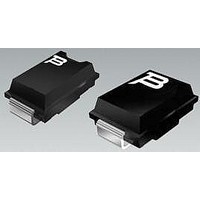TISP5115H3BJR-S Bourns Inc., TISP5115H3BJR-S Datasheet - Page 9

TISP5115H3BJR-S
Manufacturer Part Number
TISP5115H3BJR-S
Description
Sidacs Forward Conducting Unidirectional
Manufacturer
Bourns Inc.
Datasheet
1.TISP5070H3BJR.pdf
(11 pages)
Specifications of TISP5115H3BJR-S
Breakover Current Ibo Max
60 A
Rated Repetitive Off-state Voltage Vdrm
90 V
Off-state Leakage Current @ Vdrm Idrm
0.005 mA
Forward Voltage Drop
3 V
Mounting Style
SMD/SMT
Package / Case
DO-214AA
Lead Free Status / RoHS Status
Lead free / RoHS Compliant
Available stocks
Company
Part Number
Manufacturer
Quantity
Price
Part Number:
TISP5115H3BJR-S
Manufacturer:
BOURNS/伯恩斯
Quantity:
20 000
The star-connection of three TISP5xxxH3BJ protectors gives a protection circuit which has a low differential capacitance to ground (Figure 13).
This example, a -100 V ISDN line is protected. In Figure 13, the circuit illustration A shows that protector Th1 will be forward biased as it is
connected to the most negative potential. The other two protectors, Th2 and Th3 will be reverse biased as protector Th1 will pull their common
connection to within 0.5 V of the negative voltage supply.
Illustration B shows the equivalent capacitances of the two reverse biased protectors (Th2 and Th3) as 29 pF each and the capacitance of the
forward biased protector (Th1) as 600 pF. Illustration C shows the delta equivalent of the star capacitances of illustration B. The protector
circuit differential capacitance will be 26 - 1 = 25 pF. In this circuit, the differential capacitance value cannot exceed the capacitance value of
the ground protector (Th3).
A bridge circuit can be used for low capacitance differential. Whatever the potential of the ring and tip conductors are in Figure 14, the array of
steering diodes, D1 through to D6, ensure that terminal 1 of protector Th1 is always positive with respect to terminal 2. The protection voltage
will be the sum of the protector Th1, V (BO) , and the forward voltage of the appropriate series diodes. It is important to select the correct
diodes. Diodes D3 through to D6 divert the currents from the ring and tip lines. Diodes D1 and D2 will carry the sum of the ring and tip currents
and so conduct twice the current of the other four diodes. The diodes need to be specified for forward recovery voltage, V FRM , under the
expected impulse conditions. (Some conventional a.c. rectifiers can produce as much as 70 V of forward recovery voltage, which would be an
extra 140 V added to the V (BO) of Th1). In principle the bridge circuit can be extended to protect more than two conductors by adding extra
legs to the bridge.
Specifications are subject to change without notice.
Customers should verify actual device performance in their specific applications.
JANUARY 1998 - REVISED JANUARY 2007
TISP5xxxH3BJ Overvoltage Protection Series
A) STAR-CONNECTED
U-INTERFACE
PROTECTOR
Th1
Th2
Th3
- 100 V
Figure 13. ISDN Low Capacitance U-Interface Protection
APPLICATIONS INFORMATION (CONTINUED)
Figure 14. Low Capacitance Bridge Protection Circuit
SIGNAL
1
2
B) EQUIVALENT
AI5XAC
600 pF
C
C
29 pF
-99.5 V
Th1
TISP5150H3BJ
CAPACITANCES
0.5 V
D2
D1
C
29 pF
-99.5 V
D3
D4
RING
D5
D6
TIP
- 100 V
C) DELTA EQUIVALENT
26 pF
SHOWS 25 pF
LINE UNBALANCE
26 pF
1 pF
AI4XAB
- 100 V












